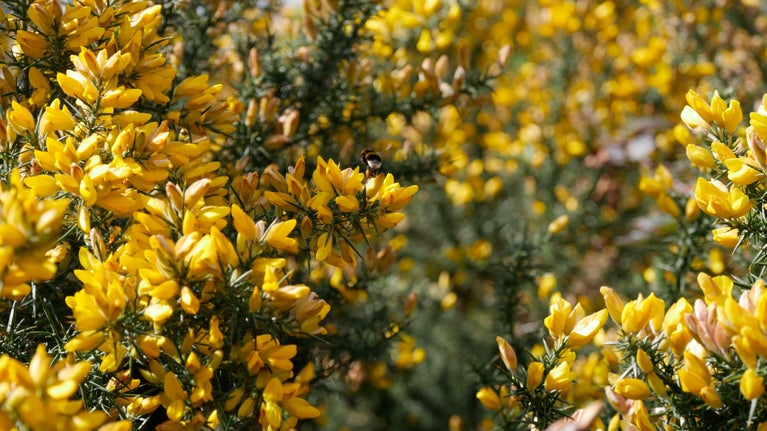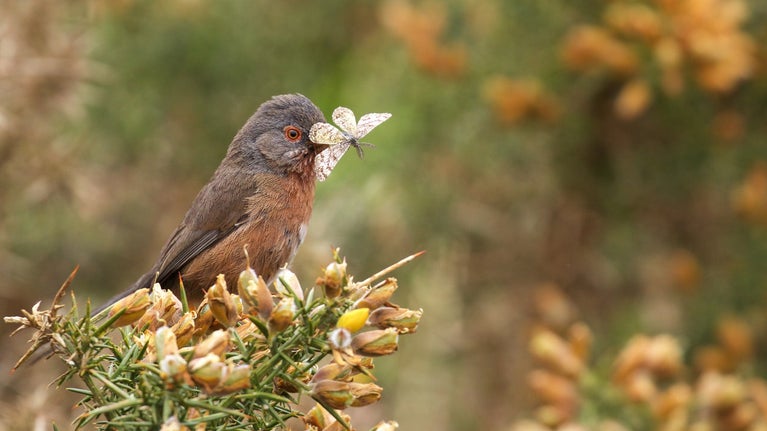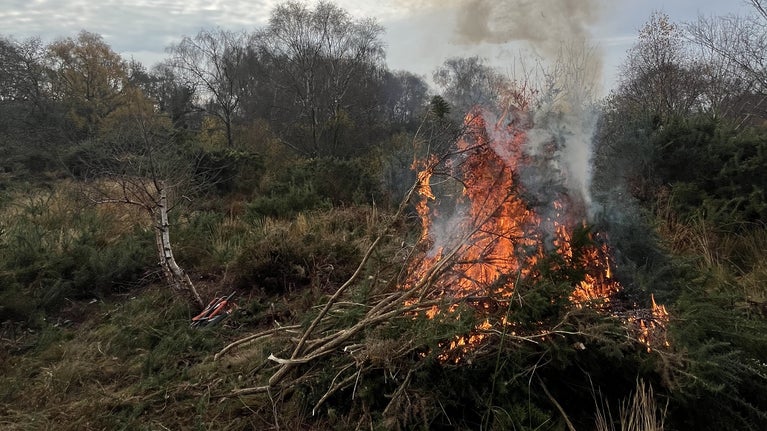Gorse - the burning question
- Published:
- 09 December 2024

With bright yellow flowers and coconut scent, common gorse is a familiar and much-loved feature of our countryside. This evergreen shrub is widespread across the UK on heathlands and coastal grasslands.
It mainly flowers in the summer, but its blossom can be seen year-round, hence the saying ‘When gorse is in season, kissing is in fashion’!
We burn small areas of gorse on the Purbeck Heaths and Corfe Common each winter. The flames and smoke can look drastic, and people sometimes misinterpret burning for wildfires. So why do we do it?
Gorse - pros
- Many birds rely on gorse for shelter and nest sites, including the rare Dartford warbler.
- Its flowers provide a year-round food source for insects, while many insects hibernate in the dense vegetation. This abundance of insects is food for birds, bats and other small mammals.
- Gorse branches, although prickly, are a food for ponies and deer.
- The colour and scent of gorse are much loved by people, and its flowers have traditionally been used for dyeing or making wine.
Gorse - cons
- Gorse is fast growing and spreads quickly. Without control it will take over heath or grasslands, causing the loss of light-loving plants and insects.
- It can burn rapidly, making it a fire hazard in dry conditions. Unmanaged blocks of old gorse are a particular wildfire risk, especially around firebreaks and buildings.
- It soon becomes ‘leggy’ and straggly, the lower stems losing their wildlife value.
- In older plants and in larger blocks, the lower vegetation rots and decays in-situ, returning nutrients to the soil which affect the delicate balance of our heathlands.

Why we burn gorse
We burn gorse as part of managing sites which are home to some of the rarest bird, reptile and invertebrate species in the UK.
- Controlled burning of gorse helps stop it spreading and creates bare patches of ground where light-loving insects, reptiles and birds can thrive.
- The new growth that follows the burning is an excellent food source for wildlife and its denseness favours nesting birds and insects.
- By burning areas, and leaving others, we create a mosaic of different aged habitats, which increases biodiversity.
- Clearing areas of the highly flammable gorse helps create fire breaks to protect the wider heathland.
- Controlling the spread of gorse helps keep the countryside accessible for walkers.
How do we safely burn gorse?
Our aim is for gorse to only cover roughly 10-15% of the heathland in total. To minimise disturbance to wildlife, especially nesting birds, controlled burning takes place from November until the end of March. Once an area has been burned, it will be left for 12-15 years so the gorse can re-establish.
- Firebreaks are created around each area to be burned to prevent the spread of flames to other parts of the heathland.
- Only skilled and experienced staff or contractors are permitted to undertake controlled burning.
- We usually wait for cold, dry and calm weather. Too strong a breeze can make fires too intense and more difficult to manage.
- We try to minimise the disruption to neighbouring houses by burning when the wind is blowing away from them – but this isn’t always possible.
- We inform the fire service before each burn so they are aware and don’t get called out unnecessarily.
Effect on the environment
Burning gorse is generally considered as a ‘carbon neutral’ land management method because:
- It reduces the use of mechanised alternatives for cutting and extracting the gorse (therefore eliminating use of fossil fuels).
- It avoids using chemicals.
- The reinvigorated regrowth reabsorbs the carbon that was released into the atmosphere.
- The emissions from small, controlled burns are substantially less than those from large damaging wildfires in summer.
- Lusher new growth following a burn can make a more positive contribution to storing carbon than the older vegetation that was there before the burn.
